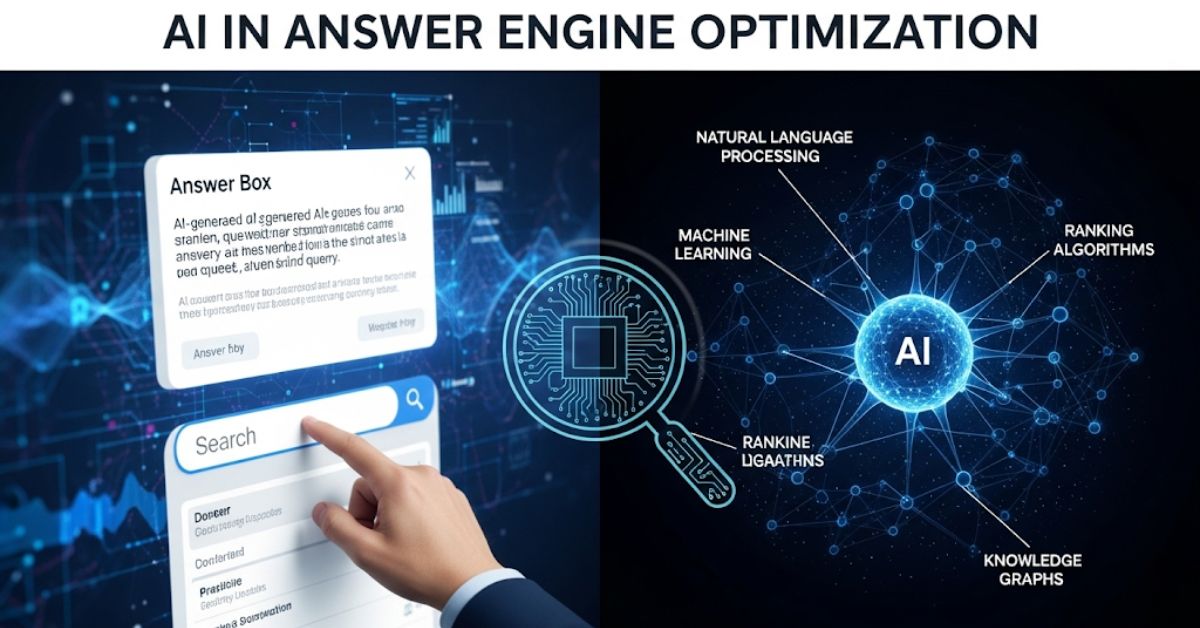In the ever-evolving world of search, Answer Engine Optimization (AEO) is gaining rapid importance. As users shift from typing keywords to asking questions directly—whether through voice, chatbots, or AI-powered interfaces—traditional SEO is no longer enough. AI-driven technologies now dominate how answers are retrieved, understood, and presented. This shift introduces a new paradigm: one where search engines act more like answer engines, using artificial intelligence to provide users with the most relevant, concise, and helpful content.
This article explores the growing role of AI in AEO, explaining how it reshapes search behavior, content strategies, and optimization techniques for websites aiming to stay relevant in this AI-first digital era.
What is Answer Engine Optimization (AEO)?
Answer Engine Optimization is the process of optimizing content to appear as direct answers in AI-powered search results. Unlike traditional SEO, which targets rankings on Search Engine Results Pages (SERPs), AEO aims to have your content used as the definitive answer by voice assistants, chatbots, and AI tools like Google SGE (Search Generative Experience), Bing Copilot, and ChatGPT.
AEO is focused on:
- Understanding user questions
- Providing direct, concise answers
- Using structured data and semantic clarity
Examples of AEO in action include:
- Featured snippets on Google
- Voice responses from Alexa or Siri
- AI-generated answers in ChatGPT or Gemini
The shift toward AEO is driven by changing user behavior, where convenience, speed, and accuracy are paramount.
How AI Is Changing the Search Landscape
Artificial Intelligence is redefining the mechanics of search. Users now ask complete questions, expecting direct and personalized answers rather than a list of links. AI technologies make this possible through their ability to understand context, intent, and language nuances.
Key changes brought by AI in search include:
- Conversational Queries: Users now type or speak in natural language, like “What are the benefits of green tea before bed?”
- Zero-Click Searches: AI answers questions directly on the results page, reducing the need to click on links.
- Dynamic Results: Personalized responses based on location, search history, or device behavior.
AI’s ability to process massive datasets and learn from patterns enables it to deliver smarter, faster, and more context-aware results. As a result, websites must optimize not just for keywords, but for answers.
Core AI Technologies Driving AEO
AI powers AEO through a combination of advanced technologies:
- Natural Language Processing (NLP): NLP helps AI understand user intent, context, and semantics. This allows answer engines to go beyond exact keyword matches and interpret meaning from sentences.
- Machine Learning (ML): AI models are trained to recognize patterns in user behavior, query types, and successful content formats. These patterns help determine what constitutes a good answer.
- Knowledge Graphs: Search engines use knowledge graphs to connect concepts, facts, and entities. These graphs enable engines to provide contextually rich and accurate answers.
- Large Language Models (LLMs): Tools like OpenAI’s GPT and Google’s Gemini can generate human-like responses by understanding complex queries and retrieving the most relevant information.
These technologies form the backbone of how answer engines find, filter, and display optimized content.
The Role of AI in Understanding Search Intent
One of the key strengths of AI is its ability to understand search intent. Rather than focusing solely on what users type, AI focuses on what users actually mean.
For example:
- A user searches “best time to water plants”—AI understands the underlying intent is related to weather, evaporation, and plant health.
- A search for “cheap flights to Paris” triggers results based on user preferences, past behavior, and dynamic pricing trends.
AI looks at factors such as:
- Query structure and context
- User location and history
- Semantics and tone of language
By accurately identifying intent, AI ensures users receive content that directly addresses their needs, making intent-focused optimization a top priority for AEO.
AI’s Role in Generating and Ranking Answers
AI doesn’t just find answers—it also ranks them based on relevance, accuracy, and structure. Here’s how:
- Featured Snippets: AI scans content for concise, structured answers (lists, definitions, steps) and elevates them into the featured snippet.
- Passage Ranking: Google can rank a specific passage from a page, even if the page isn’t well-ranked overall.
- Entity Recognition: AI identifies key entities (names, places, facts) and uses them to match content with queries.
Answer quality depends on:
- Clarity and formatting
- Use of headers and bullet points
- Authority of the source site
To be AI-optimized, content must be written for humans but formatted for machines.
Content Optimization for AI Answer Engines
To optimize for AI-driven answer engines, content must be:
- Clear and Concise: Aim to answer specific questions in the first 2–3 lines of your content.
- Well-Structured: Use H1, H2, H3 headings, bullet points, and tables for better parsing.
- Schema-Enhanced: Implement structured data like FAQPage, HowTo, and Article schema to help AI understand content purpose.
- Focused on Entities and Context: Instead of just targeting keywords like “SEO tips,” focus on connected ideas like “on-page SEO best practices for beginners.”
Best practices include:
- Writing in question-and-answer formats
- Optimizing for voice search
- Using semantic-rich language that mirrors how users naturally speak
AI Tools and Platforms Helping with AEO
A variety of AI tools can assist in crafting AEO-ready content:
- AI Writing Assistants: Tools like ChatGPT, Jasper, and Copy.ai help generate concise, human-like responses that mimic how answer engines work.
- SEO Content Optimizers: Platforms such as Surfer SEO, Clearscope, and Frase analyze top-performing content and suggest improvements based on AI analysis.
- Schema Generators: Tools like Merkle Schema Markup Generator help structure your content with the right metadata.
- Analytics Platforms: Google Search Console, Bing Webmaster Tools, and AI-integrated analytics platforms provide insights into which answers are ranking and why.
Using these tools allows SEOs to align with how AI engines evaluate and deliver content.
Challenges and Limitations of AI in AEO
Despite its benefits, AI also brings challenges to AEO:
- Content Hallucination: Large Language Models can generate inaccurate or misleading information if not properly checked.
- Over-Reliance on Automation: Relying solely on AI tools can strip content of originality, nuance, and human voice.
- Algorithm Volatility: AI-based systems evolve quickly, meaning strategies that work today may not work tomorrow.
- Bias and Fairness: AI can unintentionally reinforce bias, affecting which content gets surfaced as an answer.
Addressing these challenges requires a balanced approach: combining AI efficiency with human oversight.
Future of AEO with AI Integration
The future of AEO lies in deeper AI integration and personalization:
- Predictive Search: AI will anticipate queries before they’re asked, based on behavior and context.
- Voice and Visual Search: AEO strategies will evolve to support non-text queries.
- Real-Time Optimization: AI will suggest content edits based on live user data and performance feedback.
- Multimodal Answers: Text, video, audio, and images will blend to create richer, multi-format responses.
As AI becomes more embedded into search experiences, AEO will move from being optional to essential.
Practical Tips: How to Align Your Content with AI-Powered AEO
To make your content AEO-friendly:
- Answer Specific Questions: Identify and directly answer FAQs in your niche.
- Use Schema Markup: Implement structured data using tools like Schema.org or plugins.
- Monitor Answer Visibility: Use Search Console to identify queries triggering rich results.
- Optimize for Mobile and Voice: Ensure fast-loading, mobile-friendly pages with natural, conversational language.
- Keep Updating Content: AI rewards freshness and relevance, so update key content regularly.
These tips help bridge the gap between traditional SEO and AI-driven AEO.
Conclusion
AI has revolutionized how search engines process and present information. In this new landscape, Answer Engine Optimization is no longer just a smart strategy—it’s a necessity. As AI continues to evolve, understanding user intent, structuring data, and delivering value-rich, answer-focused content will become central to online visibility.
Businesses and content creators who adapt to AI-powered AEO will not only stay ahead of the curve but also lead the next phase of digital discoverability. The future of search isn’t just about being found—it’s about being the answer.



